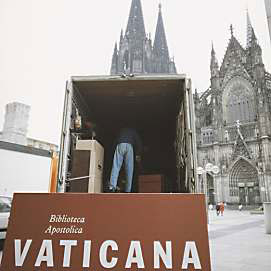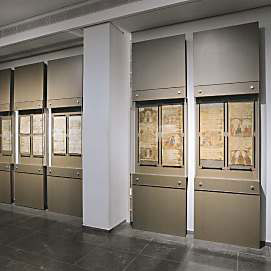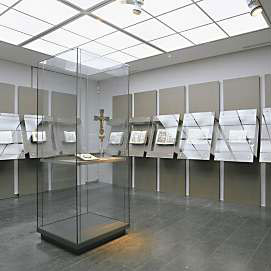1992 Vaticana
9 October 1992 – 10 January 1993
Biblioteca Apostolica Vaticana.
Liturgy and Devotion in the Middle Ages
After a year of renovation the Cologne Archiepiscopal Diocese Museum (Erzbischöfliches Diözesanmuseum Köln) reopens its doors with an exhibition of 88 of the Vatican Library’s most beautiful manuscripts. One of Europe’s oldest libraries, the Vatican Library holds more than 70,000 parchment manuscripts and an equal number of autograph manuscripts. Although it was originally planned as a private library for the popes, specific acquisitions and numerous commissions to copyists and miniaturists meant that the Vatican Library quickly grew to a vast depository of manuscripts of diverse contents, which was accessible to scholars as early as the late Middle Ages. Efforts to create a library suiting all fields of research led to Pope Sixtus IV’s bull of 15 June 1475 “Ad decorum militantis ecclesiae”, which in its aim of promoting scholarly research and culture represents the founding charter of the modern Vatican Library. The Vatican Library is unique in that since the beginning of the 17th century the bequests, donations and purchases from popes and cardinals drawn from aristocratic Italian families as well as from great bibliophiles have been preserved in their entirety in their respective “fondi”, or deposits. Because of the titles used their origins remain clearly identifiable. This is how, for example, the Fondo Palatino containing the “mother of all libraries”, as the Heidelberg Palatine Library was already called in the 17th century, was created, as were the Fondo Reginense, the library of Queen Christina of Sweden who died in Rome in 1689, and the Fondo Urbinato, the famous library of Federigo da Montefeltro, Duke of Urbino. Cologne is exhibiting manuscripts, richly decorated with miniatures, created over a thousand years between the 6th and 16th centuries. These unique works of art, mostly individually crafted, commissioned works, served the purpose of liturgy and private devotion. Though not yet illustrated, early manuscripts emphasised the authenticity of the written word by using precious materials, such as for example, the “Codex purpureus” dating from the 6th century, which was so called for its coloured parchment. Sacramentaries from the 8th century document the search for a ritualised form of worship, relying upon the authority of popes. It was only under Charlemagne that rites became standardised. The “Codex Aureus from Lorsch” originating from the court of Charlemagne as well as the Ottonian “Gospel Book of Henry II” show the imperial impact on the history of liturgy and the Church. These miniatures from Carolingian and Ottonian times are characterised by the Antique and Byzantine ideals made legitimate through age and history. The outstanding quality of the Vatican manuscript collection is documented by important Byzantine manuscripts such as the “Bible of the Patrician Leo” and the richly illustrated “Menology of Emperor Basileios II” from the 10th century, the famous “Codex Benedictus” and rare exultation scrolls and large Italian Bibles from Romanesque times. About one third of the exhibition is dedicated to Italian book illumination of the 14th to 16th centuries rarely shown in Germany. The impressive quality of achievement of the renaissance in the art of book production and painting is demonstrated by the calligraphic beauty of the pages, which were balanced according to the classical ideal, and the gemlike colour and luxuriant ornamentation as well as large scale compositions. Whereas sacramentaries, missals, antiphonaries, graduals, gospel books and lectionaries formed part of public liturgy, psalteries, breviaries and books of hours were vehicles of private devotion for people in the Middle Ages. Studios in the French and Southern Low Countries were particularly well-known for their devotional books whose often lavish presentation made them luxurious picture books for artistic enjoyment. This exhibition is displaying precious objects never before seen outside the Vatican from this final climax of late medieval Western book art as well as from the height of the Renaissance period.
Biblioteca Apostolica Vaticana.
Liturgy and Devotion in the Middle Ages
After a year of renovation the Cologne Archiepiscopal Diocese Museum (Erzbischöfliches Diözesanmuseum Köln) reopens its doors with an exhibition of 88 of the Vatican Library’s most beautiful manuscripts. One of Europe’s oldest libraries, the Vatican Library holds more than 70,000 parchment manuscripts and an equal number of autograph manuscripts. Although it was originally planned as a private library for the popes, specific acquisitions and numerous commissions to copyists and miniaturists meant that the Vatican Library quickly grew to a vast depository of manuscripts of diverse contents, which was accessible to scholars as early as the late Middle Ages. Efforts to create a library suiting all fields of research led to Pope Sixtus IV’s bull of 15 June 1475 “Ad decorum militantis ecclesiae”, which in its aim of promoting scholarly research and culture represents the founding charter of the modern Vatican Library. The Vatican Library is unique in that since the beginning of the 17th century the bequests, donations and purchases from popes and cardinals drawn from aristocratic Italian families as well as from great bibliophiles have been preserved in their entirety in their respective “fondi”, or deposits. Because of the titles used their origins remain clearly identifiable. This is how, for example, the Fondo Palatino containing the “mother of all libraries”, as the Heidelberg Palatine Library was already called in the 17th century, was created, as were the Fondo Reginense, the library of Queen Christina of Sweden who died in Rome in 1689, and the Fondo Urbinato, the famous library of Federigo da Montefeltro, Duke of Urbino. Cologne is exhibiting manuscripts, richly decorated with miniatures, created over a thousand years between the 6th and 16th centuries. These unique works of art, mostly individually crafted, commissioned works, served the purpose of liturgy and private devotion. Though not yet illustrated, early manuscripts emphasised the authenticity of the written word by using precious materials, such as for example, the “Codex purpureus” dating from the 6th century, which was so called for its coloured parchment. Sacramentaries from the 8th century document the search for a ritualised form of worship, relying upon the authority of popes. It was only under Charlemagne that rites became standardised. The “Codex Aureus from Lorsch” originating from the court of Charlemagne as well as the Ottonian “Gospel Book of Henry II” show the imperial impact on the history of liturgy and the Church. These miniatures from Carolingian and Ottonian times are characterised by the Antique and Byzantine ideals made legitimate through age and history. The outstanding quality of the Vatican manuscript collection is documented by important Byzantine manuscripts such as the “Bible of the Patrician Leo” and the richly illustrated “Menology of Emperor Basileios II” from the 10th century, the famous “Codex Benedictus” and rare exultation scrolls and large Italian Bibles from Romanesque times. About one third of the exhibition is dedicated to Italian book illumination of the 14th to 16th centuries rarely shown in Germany. The impressive quality of achievement of the renaissance in the art of book production and painting is demonstrated by the calligraphic beauty of the pages, which were balanced according to the classical ideal, and the gemlike colour and luxuriant ornamentation as well as large scale compositions. Whereas sacramentaries, missals, antiphonaries, graduals, gospel books and lectionaries formed part of public liturgy, psalteries, breviaries and books of hours were vehicles of private devotion for people in the Middle Ages. Studios in the French and Southern Low Countries were particularly well-known for their devotional books whose often lavish presentation made them luxurious picture books for artistic enjoyment. This exhibition is displaying precious objects never before seen outside the Vatican from this final climax of late medieval Western book art as well as from the height of the Renaissance period.




